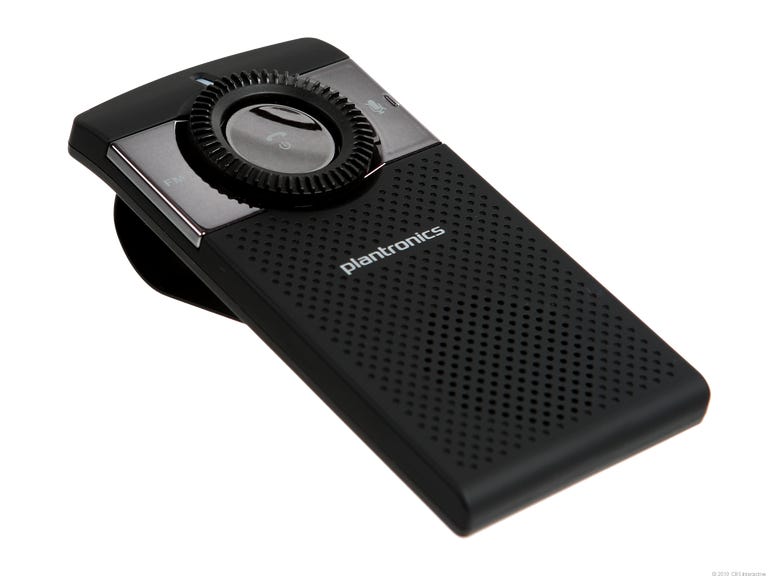In terms of form factor, the Plantronics K100 is a fairly basic visor-mounted speakerphone. Its rectangular shape and low profile are reminiscent of many similar models that we've tested, such as the Parrot Minikit Slim and the BlueAnt S4. Measuring about 2.25 inches wide by 4.5 inches long by 0.5 inches thick, the K100 is about the same size, as well. Its top surface is home to a trio of silver buttons and a rotating dial that controls the volume of the unit's 1.25-inch loudspeaker, while the bottom panel is where you'll find the metal spring clip that holds the unit in place on a vehicle's sun visor.
The Good
The Bad
The Bottom Line
Pairing and calling
Inset in the center of the volume knob is a multifunction button that serves as the user's primary point of interaction. Holding this button for 3 to 4 seconds toggles the unit's power on and off. Tapping it answers and ends incoming calls, while a double tap redials the last called number on the paired phone. Pressing and holding the multifunction button for about 2 seconds (the instructions list the duration as "two beeps") initiates voice-activated dialing on the paired phone, if supported. You should definitely check to make sure that your phone supports voice dialing before choosing this speakerphone, because (aside from basic redial) the K100 doesn't feature any sort of dialing mechanism of its own.
The K100 pairs with compatible phones using the Bluetooth Hands-Free Profile (HFP) with a four-digit PIN for the handling of calls. The unit also supports A2DP audio streaming, but there is no support for AVRCP audio controls, so you won't get the normal play, pause, and skip commands that most streaming receivers offer. When connected to a handset that also supports A2DP, the K100 can serve as a loudspeaker for music, podcasts, and turn-by-turn directions from a navigation app. However, when combined with the K100's FM transmitter, the A2DP function becomes much more useful.
FM transmission
To the left of the volume knob is a button labeled FM. Tapping this button activates the K100's wireless FM transmitter, which deactivates the unit's loudspeaker and sends all outgoing audio over an FM radio frequency. Holding the FM button initiates a scan for the clearest channel, which, once found, is announced by the K100. You can then tune your car's radio to the same frequency and, ideally, hear the speakerphone's output through the stereo's speakers. Now the K100 can serve as a bridge between a Bluetooth music phone and a low-tech FM car stereo, which is quite useful when it works.
However, we've had nothing but trouble getting FM transmitters to provide a clear, consistent signal amid the crowded airwaves of the San Francisco Bay Area, and the Plantronics K100 was no exception. We found ourselves having to rescan for clear FM stations as we passed through different parts of the city and after an evening of frustration, we eventually gave up and settled on listening to a few podcasts using the K100's great-sounding monaural speaker. Even at its best in the concrete bunker that is CNET's garage, FM-transmitted audio quality was merely passable with ever-present static--a bit like listening to a radio station from the next town over--which is fine if you listen to many podcasts or simple turn-by-turn directions, but may be annoying for those wanting to enjoy the delicacies of music. As always, your mileage may vary depending on the density of FM stations in your area and the sensitivity of your ears.
Call quality
At the business end of the K100--the leading edge that should point directly at the driver's head--is a pair of microphones. The dual-microphone setup is there to aid the K100's DSP and echo reduction, leading to clear calls, even with the audio being piped through our car's stereo at reasonable volume. Callers never complained about being able to hear themselves or about not being able to hear us.
The third button on the K100's surface is a mute button that does exactly what you'd expect it to. Additionally, holding the mute button for 2 seconds activates a "night mode" that disables the unit's blinking connection status LED. It's a small feature, but one that we found ourselves using quite a bit during our testing.
Midway down the right edge (when viewed from the top) is a Micro-USB port for charging. Included in the box are a 30-inch Micro-USB cable and a USB car charger. Charging to full can take up to 2.5 hours, but you can expect up 17 hours of talk time or 15 days of standby. And that standby time can be stretched thanks to an auto-shutdown feature that powers down the K100 after 90 minutes of unpaired inactivity. When powered back up, the K100 will automatically re-pair with the last paired phone.
In sum
Overall, the K100's call quality is good, battery life is great, and, if you can get a clear signal for the FM transmitter, it serves a second purpose as a Bluetooth-to-FM bridge between your smartphone and your car's dumb FM stereo. However, as the issues we encountered with FM transmission are inherent in the transmission method and not the fault of the K100, we didn't factor them into our score. Even if you never plan on using the FM transmission function, the K100's loud and clear internal speaker is still good enough to handle basic hands-free calling, but only for phones that have a voice-dialing function of their own.



